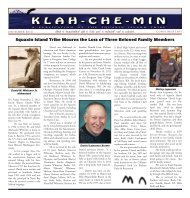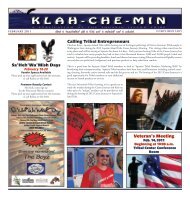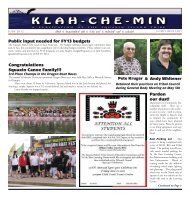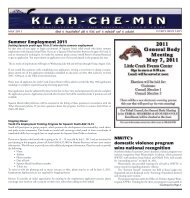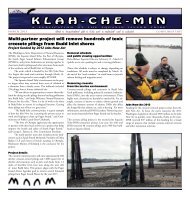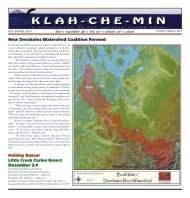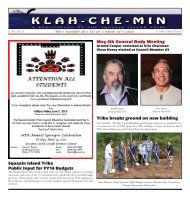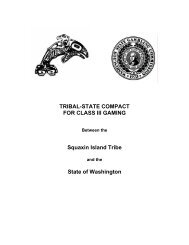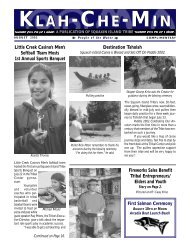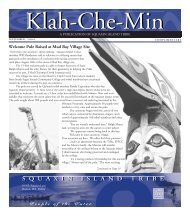Canoe Journey Guidebook - Squaxin Island Tribe
Canoe Journey Guidebook - Squaxin Island Tribe
Canoe Journey Guidebook - Squaxin Island Tribe
You also want an ePaper? Increase the reach of your titles
YUMPU automatically turns print PDFs into web optimized ePapers that Google loves.
The Sa-Heh-Wa-Mish<br />
ancestors lived and prospered<br />
throughout the Hammersley Inlet watershed<br />
in Mason County. They passed<br />
on to us a story about a man of great<br />
importance, a warrior whose name was<br />
Qawilas (Ka-wi-las). He was a brave and<br />
strong warrior. Qawilas came from the<br />
village site at the mouth of the creek<br />
in northern Case Inlet, inhabited by<br />
the band of Sqauwksin-wa-mish, who<br />
were also ancestors of the present-day<br />
<strong>Squaxin</strong> <strong>Island</strong> <strong>Tribe</strong>.<br />
It is important to remember that<br />
Salish speaking peoples in western<br />
Washington flowed throughout a vast<br />
region. It was difficult to define boundaries.<br />
Native people were like our brothers,<br />
the salmon, who traveled through the<br />
many waters of Oregon, Washington,<br />
Alaska, and British Columbia. Salmon<br />
have never had use for boundaries or<br />
the names of states or countries.<br />
Long, long ago, the Kwakiutl people<br />
came from way up north, in the area<br />
now known as British Columbia. These<br />
people raided and bothered all of the<br />
<strong>Tribe</strong>s along the southern Salish Sea.<br />
Nobody could catch them. They traveled<br />
only at night, hauled their canoes up in<br />
the woods, and rested in the daytime.<br />
They took many women and slaves from<br />
all the people around here, and at last<br />
everybody got tired of those Kwakiutl<br />
coming and raiding them.<br />
War men of the Nisqually, Sa-Heh-Wa-<br />
Mish, Snohomish, Skagit, Suquamish,<br />
Dungeness, Lummi, Cowlitz and<br />
Skykomish met at Nisqually to decide<br />
what to do about these raiders who<br />
were taking their children, wives and<br />
slaves. These men were so angry and<br />
tired of losing their people that they<br />
were ready to die fighting rather than<br />
have any more raids on their villages.<br />
The warriors made battle plans.<br />
Preparing canoes, weapons for warfare,<br />
and calling upon all of the strong young<br />
men. Preparations were made for battle.<br />
The Warrior Society exhibited battle<br />
moves and performed ceremonies<br />
of bathing and scrubbing with cedar<br />
sprigs. They sang power songs to get<br />
ready for the fight. These were songs<br />
that gave strength during battle. They<br />
were songs of spirit helpers, such as<br />
Eagle, Bear and Cougar, that had been<br />
passed down through the millennia.<br />
Clamons, very thick, thigh-length armor<br />
vests made of elk hide, were brought<br />
out for battle. Their weapons consisted<br />
of arrows. Their weapons had poison<br />
on the tips, bows, spears, war clubs and<br />
paddles, each carved to be deadly in<br />
battle.<br />
Kitsap was the best talker of that<br />
group. He lived by the water and he<br />
knew how to act on the water. Kitsap<br />
said, “You line up the canoes, side by side<br />
now. We are ready to go. My power says<br />
to me, ‘You will not die! You are coming<br />
back safe!’”<br />
Qawilas, the Sa’Heh’Wa’Mish warrior,<br />
got up before the people and said, ‘My<br />
power says I’m not going to die! I’m<br />
coming out safe!’ Then those two men<br />
stood up and talked, and everybody<br />
made ready to go.<br />
Two hundred canoes filled with ten<br />
to twelve men each from all over the<br />
Puget Sound region were sent to retaliate<br />
by raiding the Kwakiutl. The battle<br />
took place in the narrows of northern<br />
Vancouver <strong>Island</strong>.<br />
Warriors from both war parties darkened<br />
the sky with arrows. There was the<br />
sound of splintering wood as canoes<br />
were rammed by the speed of the young<br />
warriors pulling with all their might.<br />
Seasoned warriors fought with short<br />
spears or war clubs. The sound of battle<br />
filled the marine waterways.<br />
When a canoe was split in two, the<br />
Kwakiutl stopped shooting and tried<br />
to save themselves as the southern<br />
warriors shot or clubbed them in the<br />
water.<br />
A lot of people were wounded, killed<br />
or died trying to swim to safety. The<br />
battle continued until there were no<br />
more weapons left and some of the best<br />
warriors were lost on both sides. Only<br />
a few men were left from either side to<br />
return to their villages and tell of the<br />
battle.<br />
Qawilas was one who was shot and<br />
went overboard. His canoe was smashed<br />
to pieces.<br />
It took many days before news of the<br />
battle reached the father of Qawilas. His<br />
blind old father sat down and cried, “Oh<br />
my son! I don’t think he is dead! I taught<br />
him to get war power and I think<br />
that he didn’t die!” Every day<br />
Qawilas’ father wished, “I wish I<br />
could see my son again! He’s got<br />
strong power and I don’t think he<br />
died. I hope I see my son again!”<br />
Word came from the Klallam<br />
people (Kitsap & Olympic<br />
Peninsulas) that Qawilas was<br />
alive! Qawilas’ father, the old man,<br />
cried, “Oh good! Good! Good! I’ve<br />
always said every day, that my<br />
son is still living!”<br />
Although Qawilas and his men<br />
from the village of Sa-Heh-Wa-<br />
Mish lost their canoe in battle,<br />
many of them swam for survival.<br />
They found an old, buoyant<br />
snag that was large enough to<br />
ride the strong marine tides that<br />
flow from Victoria toward the<br />
Dungeness Spit near what is now<br />
Port Angeles.<br />
Dungeness people, trolling off<br />
the spit, saw something. “What<br />
is that on the snag?” they said.<br />
And then the Klallam paddled<br />
out to see what it was. By now,<br />
those Sa-Heh-Wa-Mish men<br />
couldn’t speak and they were<br />
not paddling any more. They<br />
were just going with the tide.<br />
The Klallam put them in their<br />
canoe and asked, “What are your<br />
names?” And one of them whispered,<br />
‘Qawilas.’ Their legs where<br />
they had been riding the snag<br />
were raw; there was no skin left<br />
on the inside of their legs where<br />
they had been riding that snag.<br />
The Klallam people gave a big<br />
feast to the surviving warriors.<br />
<strong>Canoe</strong>s were sent to the warrior<br />
villages to bring them to the<br />
honor feast. There was good food<br />
and the warriors told the story<br />
of the battle. Gifts were given to<br />
honor them for protecting their<br />
people.<br />
15 • paddle to squaxin 2012




